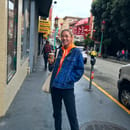I have a confession: I’m kind of a sucker for Instagram ads.
You know, those sponsored posts that subtly infiltrate your feed and next thing you know you’re contemplating whether you should blow $28 on a scrub meant specifically for your derrière? Yup. The minute they pop up on my screen, I have to scroll like a mad(wo)man just to remind myself that a.) I’m a broke college student, and b.) regular exfoliator works just fine for the behind.
That’s why when Curology showed up in my feed, I resisted the urge to click “Learn More” and move on with my life. But the concept of customized skincare was just way too interesting to pass up.
A dermatologist by the name of Dr. Lorschter originally came up with the idea of Curology with the sole purpose making “effective acne care accessible to everyone.” To start, you answer a simple–but nonetheless comprehensive–skin quiz and send in a photo of your bare skin from three different angles. With that info, Curology links you up with a licensed provider who curates a specific formula for you.
I was already sold, but just to make sure, I consulted the ultimate, empirical source of skincare reviews: Youtube. After digging through the archives of some of my favorite youtubers that dabbled in Curology–Sophia Chang, Hana Lee, and ilikeweylie to name a few–I decided to make like an overzealous frat boy and “full send.”
So, without further ado, let me begin by exposing my (bare) face on the internet.
Here are the three pictures I took as part of the Curology survey. I have oily to combination skin; I’m more oily in my T-zone (forehead, nose, and chin area) and more dry in my cheek areas. I’d also describe myself as acne prone, as you can probably tell from the scars and hyperpigmentation on my cheeks.
Here was the formula that my provider came up with: 2 % Azelaic Acid, 1% Clindamycin, and 4% Niacinamide. Azelaic acid “fights dark spots, redness, bacteria, and fungi.” Clindamycin “helps cut out inflammation brought about by acne-causing bacteria.” Niacinamide “fights acne while keeping inflammation and dark spots at bay.”
Now this all sounds fine and dandy, but did this actually work for my skin?
Week 1
The answer is no and then yes. See, what the YouTubers don’t tell you is that you may experience a period of worsening breakouts called “purging” during your first few weeks on Curology. And let me tell you, it’s not fun.
A couple large, painful (and painfully obvious) pimples sprung up on my forehead and there was never a time in the history of human existence more deserving of the phrase “not it.” But, that’s not to say that this isn’t completely normal. According to the Curology website, tretinoin and azelaic acid work by clearing out your pores, can lead to temporary breakouts in 20-25% of the patients (a statistic that I was not thrilled to be part of).
Not all is not lost though! Some of the methods that Curology recommends to combat the effects of purging include applying your formula every other night, applying moisturizer before or after application, and using an irritant-free cleanser. Personally, applying Curology over my moisturizer helped lessen the effects of the purging on my skin.
I used cleanser (purchased from my esthetician back home), the Dear Klairs Supple Preparation Unscented Toner, the Dear Klairs Freshly Juiced Vitamin Drop, the Drunk Elephant B-Hydra Intensive Hydration Serum, the First Aid Beauty Ultra Repair Cream, and then the Curology treatment. (And then the Elta MD UV Clear Broad Spectrum SPF 46 sunscreen in the morning).
Curology actually recommends using just a cleanser, moisturizer, and the treatment (at least for the first week, for adjustment purposes) but the routine I’ve listed above is what works for me.
Week 2
The perfect metaphor for my second week on Curology is a teenage glow up: quick, mysterious, but 100% worth the wait. On Wednesday, the pesky pimples from a week ago were visibly drying out, and I noticed an overall softening of my skin texture.
Week 3
AKA, this week. Like last week, I can feel a gradual improvement in the softness of my skin. However, I’ve started noticing smaller, under-the-skin pimples pop up on my forehead and in my chin area. They’re too small to be pimples and they’re flesh colored, so I’m not completely sure if they’re related to Curology.
There’s more…
You know how they say great minds think alike? Well, not to pat myself on the back or anything, but my roommates both also ordered Curology around the same time I did, (basically) completely independently of each other. We’re kind of, like, goals? (For maximum comedic value, please read the previous sentence in Elle Woods’ voice.) Here are some of their observations:
1. Maddie
Maddie first discovered Curology on Twitter, and decided to test it out after a recent break out. She had acne sophomore year of high school that never returned until she got to college. Her current skin routine consists of the Curology Cleanser, Curology treatment, and then the Curology treatment (in that order). Her formula is: 4% Azelaic Acid, 1% Clindamycin, 4% Niacinamide. In the first week, she noticed that her skin started drying out. In the second week, she experienced the dreaded “purging.” But thankfully, “Week 3 is going well” and her skin is starting to clear up.
2. Bala
When asked why she chose to start Curology, Bala said “I was really sick of fine tuning a skin care routine and felt like I was just making my skin even more sensitive and fragile from what I was using before. I just wanted a simple solution, which is where Curology comes in.” Bala, who shares my love for online skincare reviews, first discovered Curology on YouTube. Bala never really had acne growing up, although she did notice some irritation on her skin once she started threading and waxing her face in high school. She also has hypersensitive skin. Her current skin routine consists of the Curology cleanser, the Curology treatment, and then the Curology moisturizer (in that order). In the first week, she noticed drying in her problem areas but nothing too temperamental. In the second week, she started using Curology every other day, but didn’t notice a major difference in the quality of her skin. In the third week, she had virtually no acne and noticed a general smoothness in her skin.
Conclusion
All in all, I’d say Curology is worth the “full send.” If I could take away one thing from this experience, I’d say using Curology has made me more aware of the ingredients on my skincare and how they affect my overall skin health.
Please remember, that everyone’s skin is unique, and what works for me (and Bala, and Maddie) may not work for you!



